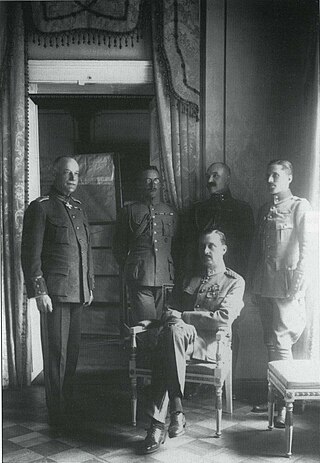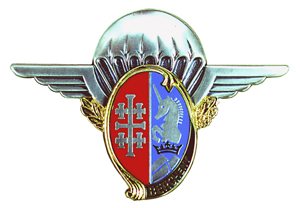A private is a soldier, usually with the lowest rank in many armies. Soldiers with the rank of private may be conscripts or they may be professional (career) soldiers.
Brigadier is a military rank, the seniority of which depends on the country. In some countries, it is a senior rank above colonel, equivalent to a brigadier general or commodore, typically commanding a brigade of several thousand soldiers. In other countries, it is a non-commissioned rank.
Sergeant is a rank in use by the armed forces of many countries. It is also a police rank in some police services. The alternative spelling, serjeant, is used in The Rifles and other units that draw their heritage from the British light infantry. Its origin is the Latin serviens, 'one who serves', through the French term sergeant.
Corporal is a military rank in use by the armed forces of many countries. It is also a police rank in some police services. The rank is usually the lowest ranking non-commissioned officer. In some militaries, the rank of corporal nominally corresponds to commanding a section or squad of soldiers.
Sergeant major is a senior non-commissioned rank or appointment in many militaries around the world.

Antoine Adolphe Marcelin Marbot, known as Adolphe Marbot, was a French general. He belongs to a family that has distinguished itself particularly in the career of arms, giving three generals to France in less than 50 years.

Adjutant is a military appointment given to an officer who assists the commanding officer with unit administration, mostly the management of human resources in an army unit. The term adjudant is used in French-speaking armed forces as a non-commissioned officer rank similar to a staff sergeant or warrant officer but is not equivalent to the role or appointment of an adjutant.

The Direction générale de l'armement, established in 1961, is the French Government defence procurement and technology agency, responsible within the Ministry of Armed Forces for project management, development, and purchase of weapon systems for the French military. The DGA's mission is to prepare the future of French defence systems, equip the French Armed Forces, as well as to promote French defence industry exports.

Rank insignia in the French Army are worn on the sleeve or on shoulder marks of uniforms, and range up to the highest rank of Marshal of France, a state honour denoted with a seven-star insignia that was last conferred posthumously on Marie Pierre Koenig in 1984.
An army corps general or corps general is a rank held by a general officer who commands an army corps. The rank originates from the French (Revolutionary) System, and is used by a number of countries. Normally, the rank is above the divisional general and below the army general, so it usually corresponds to the lieutenant general. However, in some countries such as Spain, Brazil, and Peru, the rank of army corps general is not used, in Spain the rank of army corps general is replaced by the rank of lieutenant general, while in some countries such as Brazil and Peru, the rank of army general is immediately above that of divisional general.
Divisional general is a general officer rank who commands an army division. The rank originates from the French (Revolutionary) System, and is used by a number of countries. The rank is above a brigade general, and normally below an army corps general.
Maréchal des logis is a sub-officer rank used by some units of the French Armed Forces. It is traditionally a cavalry unit rank. There are three distinct ranks of maréchal des logis, which are generally the equivalents of sergeant ranks.

The 1st Parachute Hussar Regiment is an airborne cavalry unit in the French Army, founded in 1720 by Hungarian noble Ladislas Ignace de Bercheny. It is stationed in Tarbes and is a part of the 11th Parachute Brigade.
Major Abdoulaye Adamou Harouna is a Nigerian military figure who led the military coup which overthrew President Mamadou Tandja on February 18, 2010.

Salou Djibo is a Nigerien Army officer. After President Mamadou Tandja's attempts to remain in power after the end of his term, Djibo led the military coup of 18 February 2010 that ousted Tandja, after which he became the head of the Supreme Council for the Restoration of Democracy. The Supreme Council returned power to a new civil government after the 2011 elections.

A squadron was historically a cavalry subunit, a company or battalion-sized military formation. The term is still used to refer to modern cavalry units, and is also used by other arms and services. In some countries, including Italy, the name of the battalion-level cavalry unit translates as "Squadron Group".
Commandant is a military rank used in many countries, where it is usually equivalent to the rank of major.
A general of the branch, general of the branch of service or general of the ... is a three or four-star general officer rank in some armies. Several nations divide — or used to divide — their senior general officer ranks by the branch of troops they are qualified to command, or simply as an honorific title.

Paul Gardy was Général de brigade of the French Army and Commandant of the Foreign Legion in 1951 and 1958.
Major in France, is a senior superior military rank across various military and security institutions with history dating back well beyond the 18th century.








